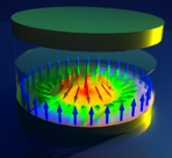 On Thursday October 24th 2024, we have the pleasure to welcome in SPINTEC Anjan SOUMYANARAYANAN Assistant professor at the National University of Singapore (NUS). He will give us a seminar at 11:00 entitled :
On Thursday October 24th 2024, we have the pleasure to welcome in SPINTEC Anjan SOUMYANARAYANAN Assistant professor at the National University of Singapore (NUS). He will give us a seminar at 11:00 entitled :
Decoding Electrical Signatures of Chiral Spin Textures
Place : IRIG/SPINTEC, auditorium 445 CEA Building 10.05 (access to CEA requires an entry authorization. Request it before 16th at admin.spintec@cea.fr)
video conference : https://webconf.cea.fr/olivier.boulle/5GFYNR49
Abstract :  Chiral spin textures such as magnetic skyrmions represent the smallest realizable emergent magnetic entities in functional materials. Their topological stability and ease of tunability in ultrathin magnetic films has generated considerable promise as robust, mobile bits for sustainable computing [1]. While spin textures are readily visualized using several magnetic imaging techniques, their electrical detection has been a topic of intense research and debate [2].
Chiral spin textures such as magnetic skyrmions represent the smallest realizable emergent magnetic entities in functional materials. Their topological stability and ease of tunability in ultrathin magnetic films has generated considerable promise as robust, mobile bits for sustainable computing [1]. While spin textures are readily visualized using several magnetic imaging techniques, their electrical detection has been a topic of intense research and debate [2].
Here, we establish robust electrical signatures of individual and ensemble spin textures stabilized across a tunable material platform [3-5]. First, we examine Hall transport across spin texture ensembles. In contrast to the claimed presence of a topological Hall effect, our systematic study unveils an unconventional anomalous Hall effect, which derives from the geometric morphology of spin textures [6]. Next, we show that the microwave spectrum of spin textures universally hosts a trifecta of resonance modes arising from irreversible transitions. In multilayers, their high-frequency spectrum can be deterministically and widely modulated via in situ analogue knobs [7].
Finally, we present a nanoscale magnetic tunnel junction (MTJ) hosting a single, ambient skyrmion [8]. The MTJ nucleates skyrmions of fixed polarity, albeit via two distinct mechanisms, with readout signal quantifying skyrmion size. Crucially, it can electrically write and delete skyrmions to both uniform states with energies 1,000 times lower than state-of-the-art MTJs. Here, the applied voltage emulates a magnetic field, and reshapes both the transition energetics and kinetics. Demonstrations of skyrmion readout, switching, and motion establish a much-anticipated backbone for all-electrical skyrmionics.
- A. Soumyanarayanan et al., Nature (2016) 539, 509.
- A. Fert et al., Nature Reviews Materials (2017) 2, 17031.
- A. Soumyanarayanan et al., Nature Materials (2017) 16, 898.
- X. Chen et al., Advanced Science (2022) 9, 2103978.
- X. Chen et al., Advanced Functional Materials (2023) 2304560.
- G.K. Krishnaswamy et al., Submitted (2024).
- T.S. Suraj et al., Submitted (2024).
- S. Chen, et al., Nature (2024), 627, 522.
Biography : Anjan Soumyanarayanan is an Assistant Professor of Physics at the National University of Singapore (NUS), and a Principal Scientist at the Agency for Science, Technology & Research (A*STAR), Singapore. He leads a team on Spin Technology for Electronic Devices (SpEED), which develops spintronic materials and devices and investigates their properties using microscopic, spectroscopic, and transport techniques. He received the 2018 IEEE Magnetics Society Early Career Award and the 2018 Singapore Young Scientist Award for related efforts.




